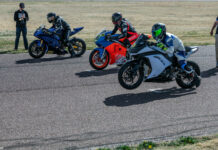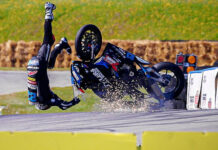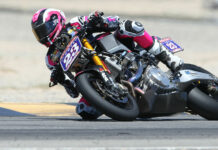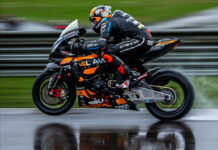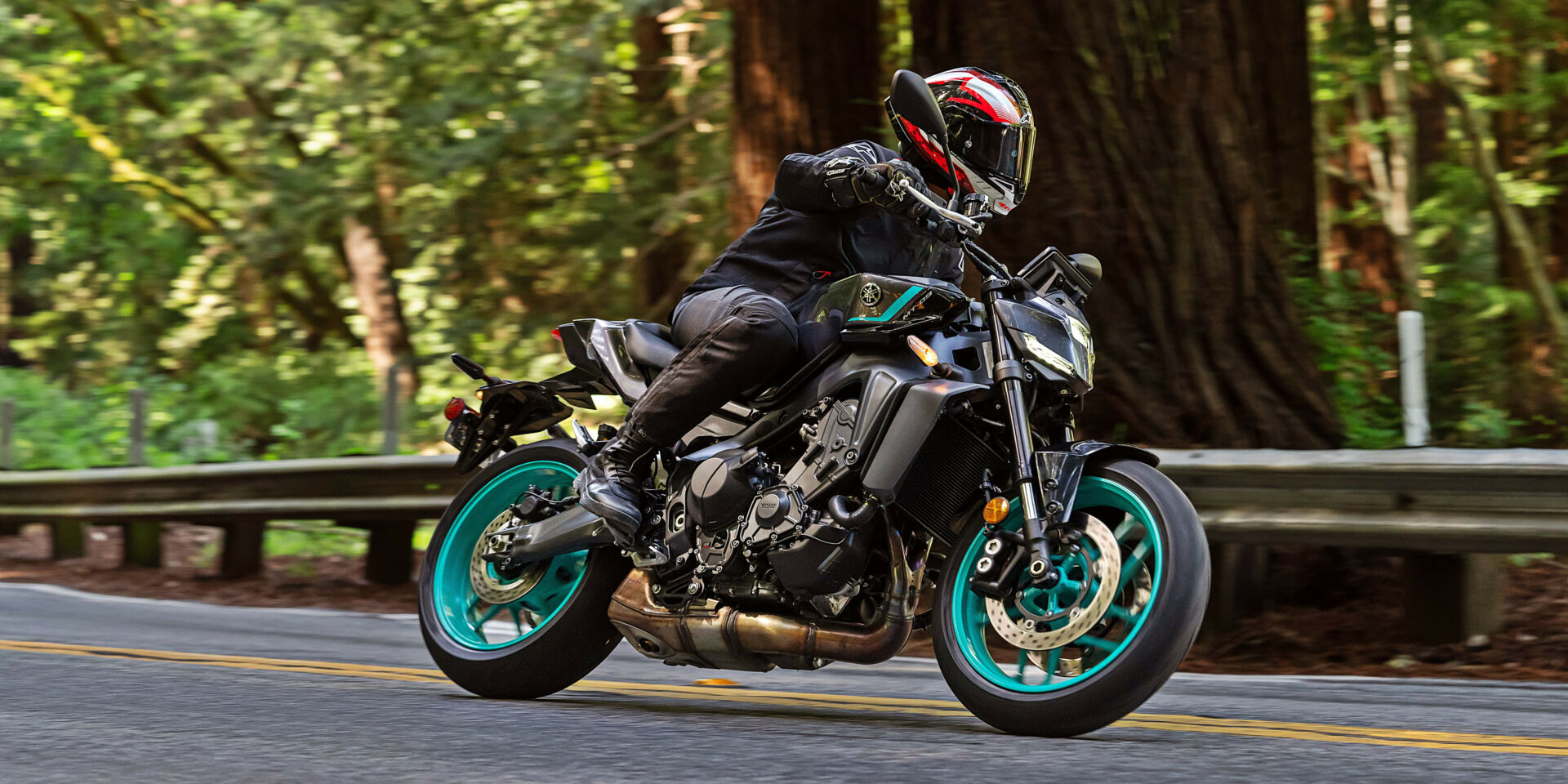Yamaha will tell you that the MT-09 is a hyper naked machine. The lack of fairing screams standard. The messaging surrounding tubular handlebars is all about comfort.
But a day of ripping around on the 2024 version of the bike that started Yamaha’s current performance-oriented Master of Torque (MT) lineup demonstrated that it’s just a ruse.
It’s a sportbike, pure and simple.
It may lack wind protection and clip-on bars, but the thing hauls, handles, and brakes. It flicks hard into corners, holds its composure mid-corner, and barrels out with the front wheel threatening to come off the ground. After about 120 miles of twisty roads in and around San Jose and Santa Cruz in Northern California, I came to the following conclusion. It goes fast, it handles, it makes you feel fast, and if that doesn’t meet the definition of sportbike, nothing does.
Tech Briefing
Yamaha established its three-cylinder hyper naked formula with the 2014 model (known then as the FZ-09) and has stuck with it. The engine has grown from the original 847cc to the 890cc of the current CP3 engine, also found in several other models in Yamaha’s lineup. Horsepower is now a claimed 117.3 bhp at 10,000 rpm, with claimed torque peaking at 68.6 lbs.-ft. at 7,000 rpm.
Changes for 2024 include a new up-and-down quickshifter system that now allows downshifts under acceleration and upshifts while decelerating. A new transmission incorporates different internal gears and six drive dogs instead of the previous five. The idea is to reduce shift lash and smooth out the gear engagement. The new gas tank cover incorporates a pair of screens that enhance the intake sound.
The riding position come from handlebars that are more than an inch and a quarter lower and pegs that are more than an inch further back and slightly higher. The tank cover is about an inch lower and more than two inches wider and is redesigned to better hold the rider’s knees in place during enthusiastic cornering. The seat is now a split design, with rider and passenger having separate seats.
The twin-spar aluminum frame gets minor adjustments to help improve handling and feel. New engine mount brackets are slightly thicker–from 3.2mm to 4.0mm on the left and from 3.2mm to 6.0mm on the right–to increase rigidity in that part of the chassis. A new headstock bracket is thinner to reduce rigidity there. The 41mm KYB forks get stiffer springs, 15N/mm from 14N/mm, and revised damping, and the single KYB shock gets revised damping and a new linkage with a flatter curve. The idea is to generate more stability and less pitch during braking and acceleration, as well as better front-end feel and more consistent feel over a wider range of riding conditions. Proprietary Bridgestone Battlax Hypersport S23 tires are mounted over lightweight 10-spoke aluminum-alloy rims.
Ride modes include Rain, Street and Sport, with two custom mode slots available for the rider who wants to fine-tune their personal selection of throttle sensitivity, traction control, slide control, wheelie control, back slip regulation and quickshifter sensitivity. The BSR (Back Slip Regulator) modulates engine brake torque in traction conditions where the slipper clutch is overwhelmed.
The styling is cleaner, the mirrors are new, and the passenger peg mounts are hidden. The new seat is narrower at the front. New switches operate turn signals that now are self-canceling and have a lane-change function–tap the switch and the signal flashes briefly, then turns itself off. The cruise control couldn’t be easier to operate. And there are four different dash display modes, including one that is inspired by a piano–lest we forget, Yamaha makes exquisite pianos.
Riding It
Yamaha’s plan for the machines powered by the CP3 engine includes softer power at the bottom end of the rpm range, with a smooth transition to a punchy mid-range and legit power at the top end. The 2024 MT-09’s throttle response is smooth and direct, even in Sport mode. I switched to Rain mode when riding down a single-lane road where the shadows from massive redwood trees hid the wet patches, and I liked the muted throttle response. Back in Sport mode, wheelies were the norm, and on a section of Pacific Coast Highway shut down for the test ride by the California Highway Patrol, we got to exceed the posted speed limit. Even at speed, the bike felt smooth, calm, and settled. At normal highway speeds, the bike was just loafing, waiting to jump when called.
The bars felt slightly wider than clip-ons, but the lower position did not result in any greater pressure on my wrists. Same with the more rearset pegs – the more aggressive riding position was no less comfortable. The engine didn’t vibrate much, the new mirrors worked, and the cruise control was responsive and sophisticated. I’ve quit apologizing for loving cruise control. I think it makes a long ride so much less taxing.
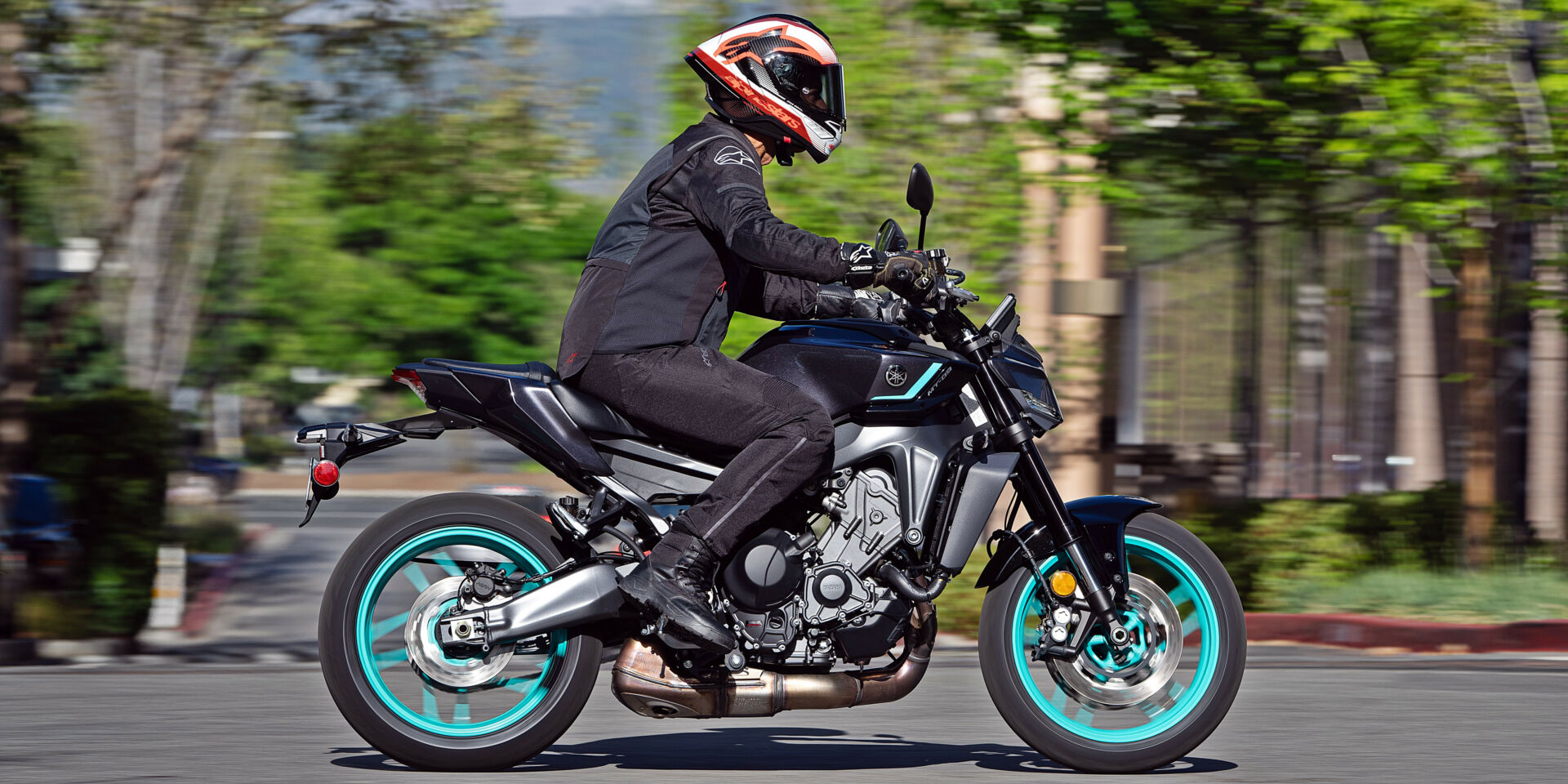
The new riding position was designed to put the rider in a more forward stance, and it felt like it gave me a more direct connection to the front wheel. The chassis changes didn’t hurt, and while the suspension components are not the most sophisticated, the bike was stable going into corners over roads bumpy enough to get the rear wheel airborne, and the machine was planted mid-corner. Yamaha got the suspension pretty close.
The Brembo radial front master cylinder felt solid and works with a pair of Advics calipers and 298mm twin discs up front. And, as I have noted in several of my past MT-09 reviews, there was definitely a rear brake attached to the machine. What it does, I have no idea.
The new quickshfter system is one of the best I’ve used. The seat is plenty comfortable. I wish there was a way to bypass the two Custom ride modes and just use the Mode button to toggle through Rain, Street and Sport, but isn’t that a first-world problem?
Yamaha got the original FZ-09 right and has spent a decade honing the bike. This version is the best one yet. Yeah, it’s fairing-free, clip on-free, etc., but the MT-09 is a sportbike just the same.


